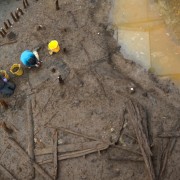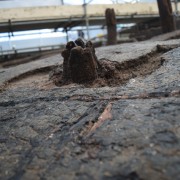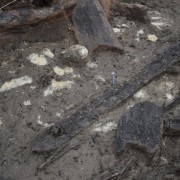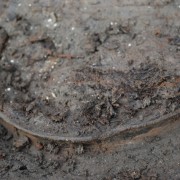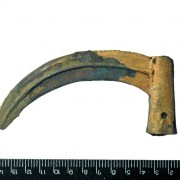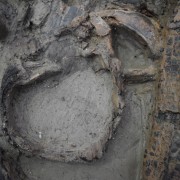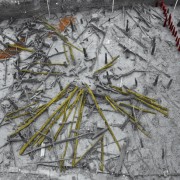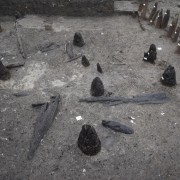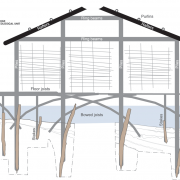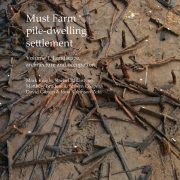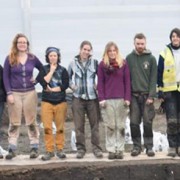Dig Diary 17: Formality and the Must Farm Settlement
February 15, 2016
Conventional or Unconventional Site?
Early on in the project we discussed a number of different interpretations of the site based on the material recovered during the 2006 excavation. People’s interpretations varied from the site being a hugely significant, “special” timber platform to a site that didn’t contain enough wood to be a building. Now that we have excavated a much larger area and are beginning to uncover occupation material, what are our current thoughts?
It is important to emphasise that the archaeological process is very much open to interpretation. Discussing a variety of different options and theories is essential in helping us to consider the finds and deposits we are encountering. Often it takes different specialists and outside experts to help raise new questions and thoughts that we might not have considered. Our own interpretations change with the project, sometimes on a day-to-day basis.
So, were the round houses that we have uncovered the homes of an extended family? Or were these structures perhaps something more “special”? This is a difficult set of questions to answer, given the wide variety of evidence that we have to consider, but already we are beginning to identify certain elements. Structurally, the round houses are providing us with some really fascinating insights into Fenland life during the Late Bronze Age.
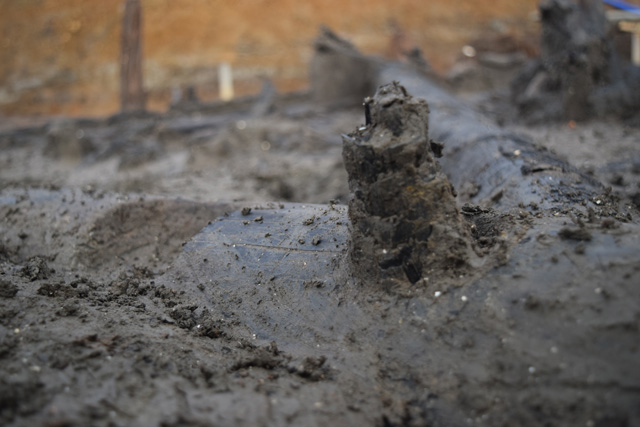
Tenon still sitting within joint. To the left of the image is an empty mortise located on the same timber.
Architecture
The pile-dwellings built over the river have a distinct “formality” to them. There seems to be a distinct, organised method to their construction that suggests a well-organised and carefully planned template to the design. All of the posts in the interior and exterior rings are made from the same wood (oak) and have incredibly similar dimensions. Similarly, the palisade around the settlement is constructed from ash posts of the same measurements.
Examining the wood has shown that the timber has come from managed woodlands. The ash has been grown for a period of approximately 15-20 years before being used in the construction of the palisade. This is evidence of clear forward planning by the Bronze Age communities, they were preparing for the construction of settlements. However, they also knew the type of wood they wanted for the palisade and also for the structures themselves. It seems that these stilted buildings were not some special variant of a round house that was suddenly thrown up over a river with whatever resources they could gather.
Instead, they seem the direct result of a “culturally” considered building that was familiar to the people of the time. Looking at similar round house structures from a few miles away reveals very similar elements. At the nearby site of King’s Dyke, round houses built on dry ground have similar construction forms in terms of their shape and size (houses from both sites are around 8m in diameter). Even though the Must Farm houses are built on stilts over a river it is a still a style of building common to the period, very reminiscent of the posthole houses we find on the dry ground. These structures are as culturally diagnostic as pottery or metalwork.
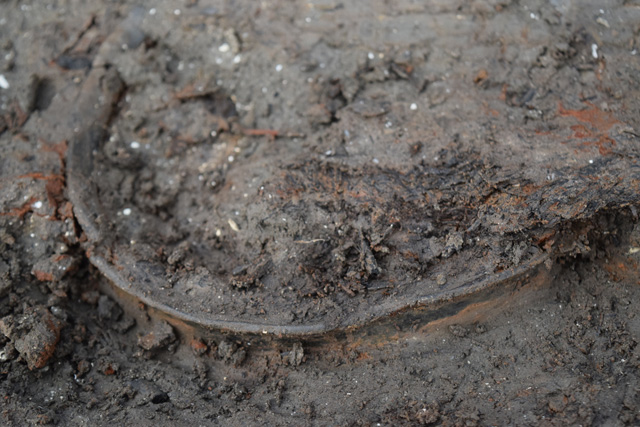
The rim of a vessel just beginning to emerge from the silt.
Pottery
One of the most discussed artefacts from the project has been the amazing ceramic assemblage. The range of pottery is fantastic as it appears to reflect a complete, domestic set. Everything from the smallest, individual drinking vessels to the large, coarseware storage vessels are present and in significant quantities. The consistency in style and design across all the vessel types is particularly remarkable.
The pots are characteristic of Late Bronze Age ceramics that again feels indicative of a household rather than something extraordinary. People have argued that the complete nature and lack of broken vessels is unusual. However, we currently don’t know what the lifespan of the settlement was. It is very possible that the settlement was short-lived and its life curtailed by the enormous fire that tore through it. If it did have a limited life then it makes sense that most vessels are still complete: not enough time had passed for vessels to break and be discarded.
Equally, other domestic material can potentially help us understand the nature of the settlement and also its duration. We have already discovered a small number of querns, which are also indicators of domestic practice. At the end of the excavation, if we only have a fairly small number of these objects, it will help to suggest that the site had a fairly brief duration. Similarly, their presence on site also implies that they were being used as part of a daily routine to process some of the cereals we have found in environmental samples.
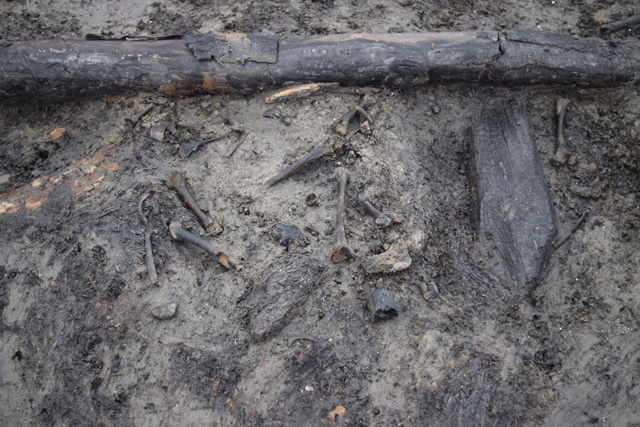
Cluster of animal bone emerging from the occupation deposits within the round house.
Animal Bone
One of the most recent groups of finds beginning to emerge from the occupation deposit are small clusters of animal bones. These are excellent illustrations of domestic process and we have just started to see some patterning in these bones. Bone clusters located outside the extent of the first round house mainly consist of pigs and deer bones, whereas those from inside the house are dominated by butchered lambs.
Closer examination of the pig and deer bones from outside the house reveal signs of butchery and the clusters generally consist of disarticulated material. This is very suggestive that these bones are the remains of the butchery process and were discarded. The sheep remains from inside the structure show partial articulation, potentially the result of meat hanging up within the building. This mutton looks to be pre-meal storage that was inside the structure as it burnt down.
This is still an early, very much preliminary, assessment of this material but a pattern definitely seems to be emerging. As the excavation concludes we’ll be able to examine the faunal remains in much greater detail and get a more refined understanding of any specific patterning related to the settlement. However, it is very interesting that even at this relatively early stage of exploring the occupation deposits that this kind of material patterning is emerging.
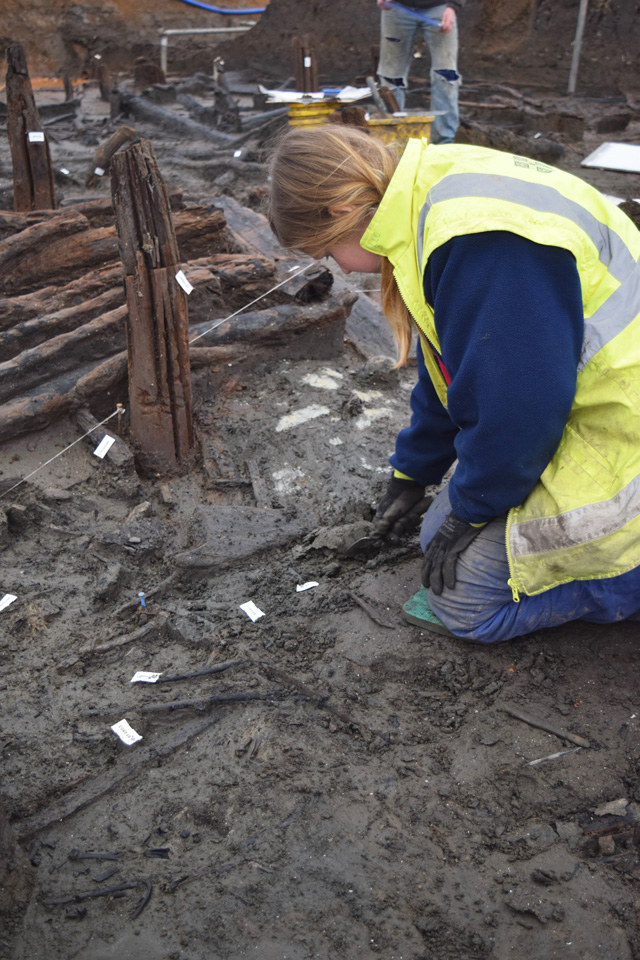
Working shot showing the beginning of the excavation of the occupation deposit.
A Settlement with Routines?
At this stage of the project, it seems that our initial interpretation that the site could be a representative Late Bronze Age settlement has some merit. The notion that the Must Farm site is some form of extraordinary, “special” structure does not seem to be holding up. None of the material we have recovered, so far, appears notably unusual.
The preliminary work on animal bone positioning seems very consistent with general domestic practice. Similarly the ceramic assemblage is providing us with a detailed look at the vessels used in a variety of roles, seemingly in everyday situations. Currently, our thoughts are that the round houses at Must Farm are a representative example of Late Bronze Age life in the Fens. While the site’s demise and its unique preservation are undoubtedly exceptional, there is little evidence, so far, that the structures themselves are anything other than a conventional settlement.
As with anything in archaeology, this current hypothesis could be quickly challenged depending on the material we find as we progress further with the excavation. However, we are recognising a distinct element of formality or routine to the archaeology we are uncovering. This routine seems to be concerned with the more mundane, and not extraordinary practices, familiar to the Later Bronze Age. As the excavation continues and we get further into the occupation deposits, we’ll be finding much more evidence to help us shape and refine our interpretations.
Related stories
Dig Diary 20: Excavating in the Fenland Landscape
March 7, 2016
Dig Diary 19: Discovering Britain’s Oldest, Complete Wheel
February 29, 2016
Dig Diary 18: Looking Inside and Outside Roundhouse One
February 22, 2016
Dig Diary 17: Formality and the Must Farm Settlement
February 15, 2016
Dig Diary 16: Earlier and Later Periods in the Fenland Basin
February 8, 2016
Dig Diary 15: Exploring the Occupation Deposit
February 1, 2016
Dig Diary 14: Excavating our Structures
January 25, 2016
Dig Diary 13: Exploring Our Earlier Oak Post Alignment
January 18, 2016
Learn more
About
The Must Farm pile-dwelling settlement was excavated by the Cambridge Archaeological Unit with funding from Historic England and Forterra.Publications
Read the Open Access publications the Must Farm pile-dwelling settlement: Volume 1. Landscape, architecture and occupation and Volume 2. Specialist reports.Post-Ex Diaries
Our work on-site has finished but lots more investigation is taking place as we study both the material and the evidence we recovered. ...read more
Discoveries
See some of the discoveries from the Must Farm pile-dwelling settlement.
Making Must Farm
Find out about our work with AncientCraft recreating Must Farm’s material.
FAQs
Further information on the Must Farm project.

